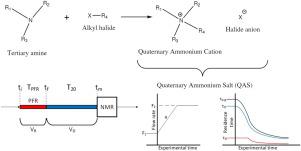Chemical Engineering Research and Design ( IF 3.7 ) Pub Date : 2021-02-23 , DOI: 10.1016/j.cherd.2021.02.021 Roel J.T. Kleijwegt , Sven Y. Doruiter , Wyatt Winkenwerder , John van der Schaaf

|
Quaternary ammonium salts are readily utilised within the chemical industry as, e.g., phase-transfer catalysts and anti-microbials, and their annual production capacity exceeds 1 million tonnes. These surfactants are conventionally produced in batch Menshutkin reactions from tertiary amines and an alkyl halide. With an incentive to move towards a more efficient continuous process, a better understanding of its kinetics is paramount. This paper explores a novel method to determine kinetic parameters, by introducing a linear flow ramp, combined with in-line Proton Nuclear Magnetic Resonance (H NMR) analytics.
Batch reactions between N,N-dimethyldecylamine (DMDA) and benzyl chloride (BnCl) have been performed in various solvents to examine solvent effects, and to validate the ramp-flow method. H NMR spectrometry showed that acetonitrile had the highest reaction rate, while methanol (MeOH) was deemed to have the best overall potential with regards to process intensification and product separation.
Kinetic data was also obtained in a Plug-Flow Reactor (PFR) subjected to ramp-flow, under continuous measurement of the outlet stream composition. Between 20 and 70 C, DMDA quaternisation rates were determined in MeOH, using both BnCl and methyl iodide reactants. This resulted in the successful elucidation of the respective Arrhenius parameters.
Furthermore, the data from the ramp-flow method has been compared with the data obtained in batch, and in the PFR under conventional steady-state conditions. In general, all three methods were in good agreement, and it was concluded that the proposed method is valid. This method can thus provide a more efficient way to determine highly accurate kinetic parameters.
中文翻译:

在串联流式反应器中使用斜流研究叔胺烷基化/苄基化动力学 1 H NMR光谱
季铵盐很容易在化学工业中用作例如相转移催化剂和抗微生物剂,它们的年生产能力超过100万吨。这些表面活性剂通常是由叔胺和卤代烷以间歇Menshutkin反应生产的。为了激励人们朝着更有效的连续过程发展,对它的动力学的更好的理解是至关重要的。本文探索了一种新的方法来确定动力学参数,方法是引入线性流坡道,并与在线质子核磁共振相结合(1 H NMR)分析。
N,N-二甲基癸胺(DMDA)和苄基氯(BnCl)之间的间歇反应已在各种溶剂中进行,以检查溶剂的作用并验证斜流方法。 1 H NMR光谱显示乙腈具有最高的反应速率,而甲醇(MeOH)被认为在工艺强化和产物分离方面具有最佳的整体潜力。
在连续测量出口物流组成的情况下,在经历斜流的塞流反应器(PFR)中也获得了动力学数据。在20至70之间C,使用BnCl和甲基碘反应物,在MeOH中确定DMDA季铵化速率。这样就成功地阐明了各个阿伦尼乌斯(Arrhenius)参数。
此外,已经将来自斜流方法的数据与批量获得的数据以及在常规稳态条件下在PFR中获得的数据进行了比较。总的来说,这三种方法都非常吻合,并且得出结论:所提出的方法是有效的。因此,该方法可以提供更有效的方法来确定高精度的动力学参数。











































 京公网安备 11010802027423号
京公网安备 11010802027423号